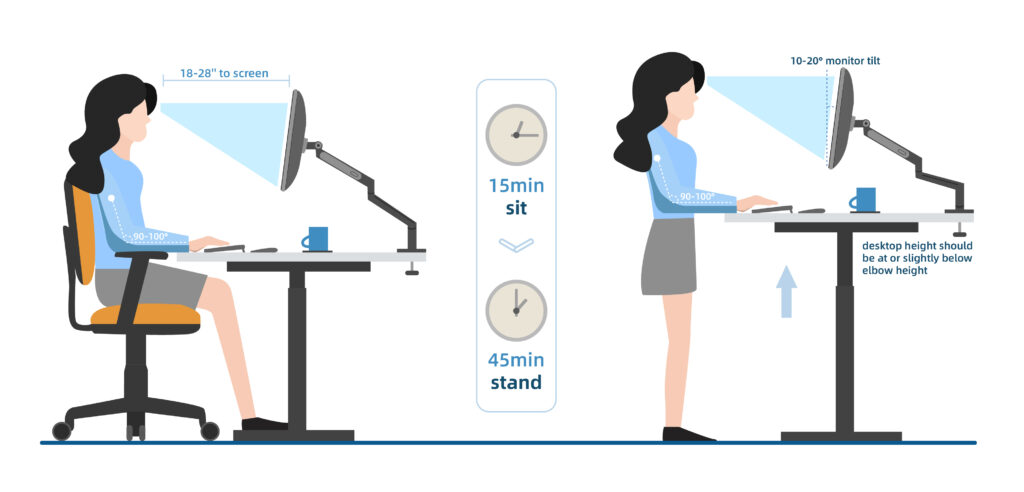We’ve covered the benefits of standing desks in previous articles, but since the body is different for everyone, it’s essential to know how to measure the correct height in order to get the most out of your standing desk.
So how do you calculate the height of a standing desk? You have to take into consideration some factors such as the height of the person, the height of the monitor, the distance to the screen, and the position of the keyboard and mouse. Once you figure out all these details, it’s straightforward to calculate the height that’s best for you.

The Desk Height
When you stand up straight, make sure that your chest is up, your shoulders are straight back, and your hands are stretched down, keeping your head, neck, and spine in a straight line. Also, your forearms should always be flat on the surface of the desk, i.e. parallel to the floor and the desk. This basically means that your elbows need to be at a 90-100-degree angle to the ground.
Note the distance from your elbows to the floor, and then consider the height of your keyboard, that’s your perfect standing desk height. As a rule of thumb, the ideal height for a standing desk should be at or slightly below elbow height.
The Monitor Height and Screen Distance
Whether you’re using a PC or a laptop, it’s important to make sure that the monitor’s height isn’t too low or too high, which would put more stress on your neck, back, and shoulders.
Adjust the monitor’s height, the ideal ergonomic height suggests your eyes line up with the top 1/3 of the monitor. Tilted the monitor backward at 10 to 20 degrees to ensure that you don’t have to tilt your head while you are working for a better view of the screen. And help you reduce neck pressure. You can elevate the monitor to the right height with the help of the monitor arm.
You’ll also want to make sure the screen isn’t too far or too close, which can cause blurred vision and headaches. The distance is not absolute, but the general consensus is to place the screen about 18-28 inches from the eye.
The Keyboard and Mouse Position
Once the desk and monitor heights are determined, it’s time to set the keyboard and mouse heights.
Working on a computer for long periods of time can strain your wrists, and it’s important to optimize your wrist position when sitting or standing, so always keep your keyboard and mouse at the same level, and keep your wrists straight when typing.
Your arms should be comfortably at a 90-100-degree angle when you’re going to use the keyboard and mouse. Too low or too high is not ergonomic and can cause wrist, elbow and shoulder discomfort and muscle tension.
The Chair Height
The correct seat height is often overlooked.
Choose a chair with an adjustable back, or add lumbar support to the chair to maintain good posture and allow your back to rest, which can take pressure off your spine.
Tilt the seat forward slightly with your feet flat on the floor. The backrest should ensure that your spine remains in a natural position when you sit and work. When seated, there should be a small space between the back of your knees and the edge of the chair. Both hips and knees should be close to an ergonomic 90-degree angle.
The chart below can be used as a reference to help you calculate the right sitting and standing desk height for you based on your height.
| User Height | Sitting Desktop Height | Standing Desktop Height |
| 5’0” | 22.5” | 36.5” |
| 5’1” | 23” | 37” |
| 5’2” | 23” | 37.5” |
| 5’3” | 23.5” | 38” |
| 5’4” | 24” | 39” |
| 5’5” | 24.5” | 39.5” |
| 5’6” | 25” | 40.5” |
| 5’7” | 25” | 41” |
| 5’8” | 25.5” | 41.5” |
| 5’9” | 26” | 42.5” |
| 5’10” | 26.5” | 43” |
| 5’11” | 27” | 43.5” |
| 6’0” | 27” | 44” |
| 6’1” | 27.5” | 44.5” |
| 6’2” | 28” | 44.5” |
| 6’3” | 28.5” | 46” |
| 6’4” | 28.5” | 47” |
| 6’5” | 29” | 47.5” |
| 6’6” | 29” | 48” |
| 6’7” | 29.5” | 49” |
| 6’8” | 30” | 49.5” |
Take a moment to consider your posture. Whether sitting or standing, while subtle daily posture changes won’t cause harm in the short term, it’s important to take care of your spine by practicing good posture so that in the long run, you don’t develop neck pain, lower back pain, or other health problems.
Using a height-adjustable desk is really great for your health. You can read more about the benefits of standing desks in this article. However, it may be difficult for you to get used to after just replacing it, and improper use can even cause some problems. Follow the tips in this article to maximize the benefits of a standing desk while minimizing risks.
Also, your heel height may affect your experience with a standing desk.
If you usually wear heels and flats at the office, you will need two different desk heights, so a fixed standing desk may not be right for you, try to choose a desk with adjustable height, preferably with a programmable height memory function, so that when you use it, one-key switching is easier and more comfortable.
Here, I would like to recommend the AK2YJYT-TYZB3, which offers a 21-42.3 “height adjustment range should help you achieve an ergonomic painless posture, whether you are a petite or tall user.
